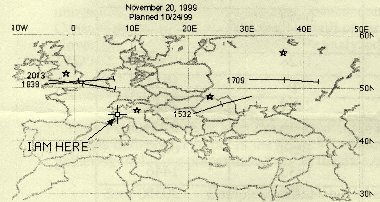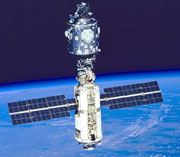 |
Last INSPIRE
mission of MIR
In November
1999 we had the last INSPIRE operations, consisting in the emission of
signals at 10 and 1000 Hz. The Russian space station MIR will probably
re-enter the atmosphere by first quarter of 2000.
Two antennas
have been used to monitor these emissions: a vertical, top-loaded Marconi
'Tee' for the vertical field and a large horizontal loop for the horizontal
field. |
PASSES DETAIL
| The arrow on a map show the receiving station position
(my QTH). On all passes, MIR moves from west to east (left to right). The
ground track shown is 2 minutes long which corresponds to the actual firing
time of ISTOCHNIK. The passes are numbered with the UT start time on the
dare indicated on the top of the map. On the track maps, the start time
appears near the western end of the track. All the european passes has
been monitored. |
 |
MODE OF OPERATION
The two instruments on MIR are Ariel and ISTOCHNIK.
Ariel is a plasma generator and operates for 5 minutes, alternating between
axes. ISTOCHNIK is a modulated electron gun that accelerates a beam of
electrons and emits them into space. The electron beam is turned on and
off at frequencies of either 10 Hz or 1000 Hz, which should cause the radiation
of electromagnetic waves in the VLF range at those two frequencies. ISTOCHNIK
operates for a total of 2 minutes on the following schedule:
10 seconds modulated at 10 Hz
10 seconds modulated at 1000 Hz
10 seconds modulated at 10 Hz
10 seconds modulated at 1000 Hz
repeat for 2 minutes of operation.
On each pass, Ariel was either operated first or
last, whichever gives the most coverage over INTMINS observers. Since the
signal from ISTOCHNIK is more powerful, it was the one most likely to be
detected. For that reason the schedule emphasizes the operation of ISTOCHNIK.
MONITORING RESULTS
For each session corresponding to a MIR pass four
sonograms have been recorded, monitoring vertical and horizontal fields
in the 0-86 Hz and 940-1122 Hz bands. The MIR emissions, lating two minutes,
are approximately in the middle of each sonogram. All operations were automatic
and pre-programmed to avoid operating errors.
Click to see the four spectrograms
of each pass:
 |
E20-1 (East Europe)
E20-2 (Russian)
E20-3 (North Europe)
E20-4 (north Europe)
E21-3
(Italy)
E21-4 (Russian)
E21-5 (East Europe)
E27-1
(Italy)
E27-2 (Russian)
E28-1
(Italy, in this pass above my QTH)
E28-2 (Russian)
E28-3 (East Europe) |
CONCLUSIONS
The large antennas used (Marconi 'Tee' 11 m high,
45 m wide; 120 m circumference loop, three turns) allowed a great sensitivity,
demonstrated by the evidence of Schumann resonances in the vertical records.
However no emissions from MIR were detected, even in direct over-head passages.
My conclusion is that using the current setup, in terms of power to the
electron beam, the signal strenght is insufficient to allow reception at
ground.
Probably the noise power present is by far too
large, or the ionosphere screening factor is very high at those ULF/ELF
frequencies.
Return to the index


